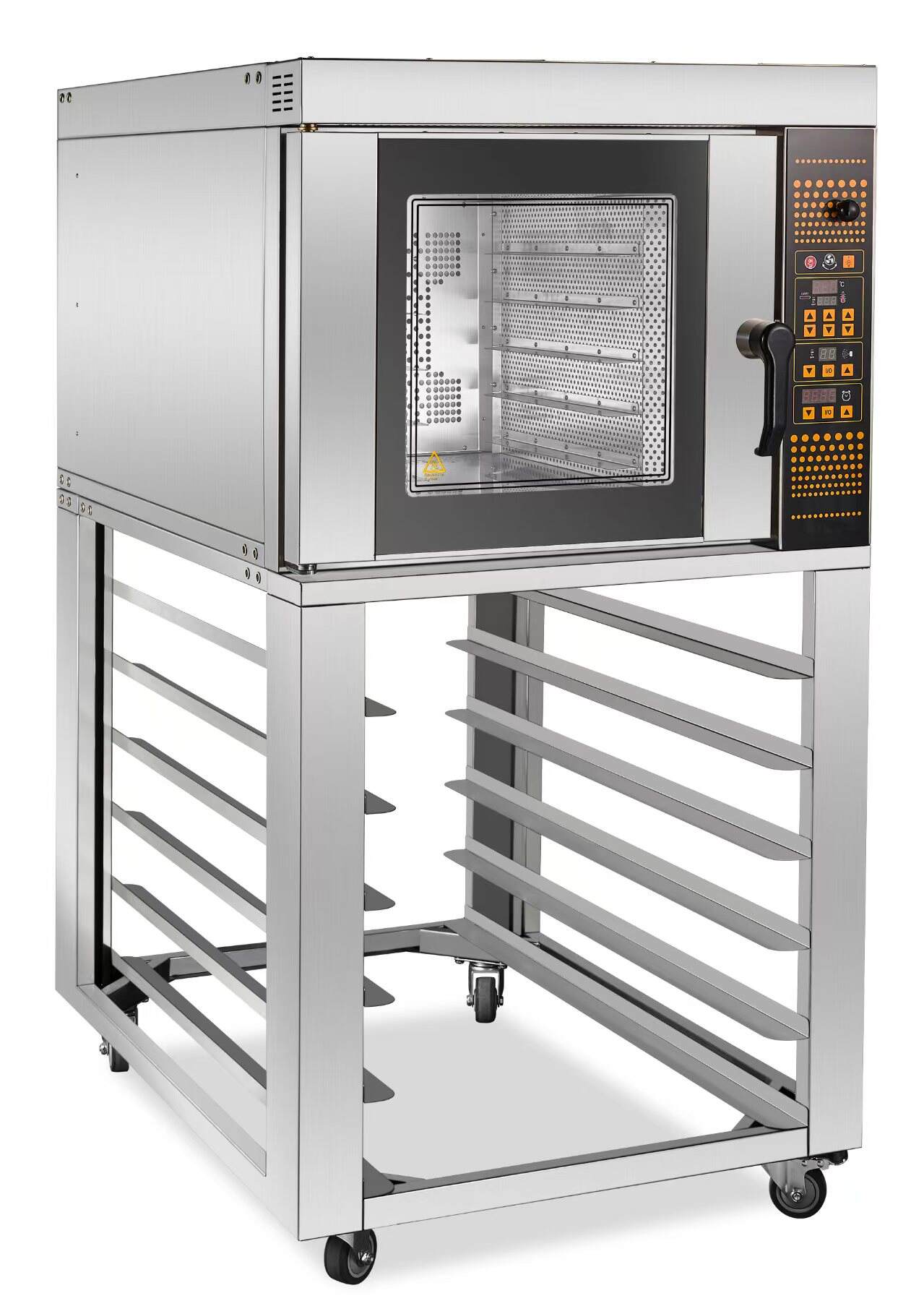ข้อควรระวังด้านความปลอดภัยที่จำเป็นก่อนการทำความสะอาด
ปิดแหล่งจ่ายไฟฟ้าและปล่อยให้เตาเย็นสนิท
ก่อนอื่นเลย ก่อนที่คุณจะเริ่มทำการปรับแต่งใด ๆ ควรตรวจสอบให้แน่ใจเสมอว่าเตาอบแบบคอนเวคชันของคุณถูกปิดการทำงานอย่างสมบูรณ์แล้ว ขั้นตอนนี้ไม่สามารถข้ามได้ เนื่องจากอาจก่อให้เกิดประกายไฟที่เป็นอันตรายได้ ควรปล่อยเตาอบแบบคอนเวคชันไว้ไม่น้อยกว่า 30 นาทีหลังจากปิดเครื่อง เพื่อให้เตาอบเย็นตัวลงและป้องกันการเกิดแผลพุพองหรืออุบัติเหตุอื่น ๆ เนื่องจากเตาอบแบบคอนเวคชันยังคงเก็บความร้อนค้างอยู่ภายในเป็นเวลานาน ตรวจสอบให้แน่ใจว่าคุณได้ถอดปลั๊กเครื่องใช้ไฟฟ้าออกแล้ว — เพิ่มอีกระดับความปลอดภัยเพื่อป้องกันไม่ให้คุณเปิดเครื่องโดยไม่ได้ตั้งใจในขณะที่คุณกำลังทำความสะอาด ข้อแนะนำเหล่านี้จะช่วยให้ผู้ใช้งานสามารถทำความสะอาดพื้นที่ได้อย่างปลอดภัย และป้องกันอุบัติเหตุที่ไม่จำเป็น
ถอดตะแกรงและอุปกรณ์เสริมออกอย่างปลอดภัย
หลังจากที่คุณแน่ใจว่าเตาอบแบบคอนเวกชันได้ถูกปิดสนิทและเย็นตัวลงอย่างสมบูรณ์แล้ว ให้ค่อยๆ ถอดชั้นวางหรืออุปกรณ์เสริมต่างๆ ออก ตรวจสอบว่าแต่ละชิ้นเย็นพอที่จะไม่ทำให้คุณเกิดการไหม้ และคุณควรตรวจสอบสภาพของแต่ละส่วนเพื่อดูว่ามีความเสียหายหรือไม่ ก่อนเริ่มทำความสะอาด เพราะความเสียหายอาจทำให้อุปกรณ์ใช้งานไม่ได้ ดังนั้นขั้นตอนนี้จึงสำคัญมาก ระหว่างทำความสะอาด ให้วางชั้นวางและอุปกรณ์เสริมไว้ในบริเวณที่ปลอดภัย เพื่อป้องกันการชำรุดโดยไม่ตั้งใจ รวมถึงเพื่อให้ชิ้นส่วนทั้งหมดอยู่ครบ การปฏิบัติตามขั้นตอนเหล่านี้จะช่วยให้การทำความสะอาดเป็นระบบและมีประสิทธิภาพมากยิ่งขึ้น
ขั้นตอนการทำความสะอาดเตาอบแบบคอนเวกชันสำหรับเบเกอรี่
เช็ดพื้นผิวด้านในและใบพัดพัดลม
เพื่อรักษาประสิทธิภาพสูงสุดของเตาอบแบบพัดลมของคุณ สิ่งสำคัญคือต้องทำความสะอาดพื้นผิวด้านในและใบพัดพัดลมเป็นประจำ ให้ใช้ฟองน้ำหรือผ้าที่นุ่มพร้อมน้ำอุ่นผสมสบู่เช็ดบริเวณภายในทั้งหมดอย่างเบามือ โดยระวังอย่าให้ขีดข่วนพื้นผิว เพื่อให้สามารถกำจัดคราบสกปรกได้ง่าย ช่วยรักษาสภาพแวดล้อมและความสามารถในการทำงานของเตาอบ ควรใส่ใจเป็นพิเศษกับใบพัดพัดลม เนื่องจากมักจะมีคราบน้ำมันสะสมซึ่งอาจทำให้ประสิทธิภาพของเตาอบลดลง เมื่อทำความสะอาดเสร็จแล้ว ควรเช็ดให้แห้งภายในเพื่อป้องกันการเกิดเชื้อรา การรักษาความสะอาดของเตาอบอยู่เสมอจะช่วยให้เตาอบกระจายความร้อนได้อย่างทั่วถึง ซึ่งนอกจากจะประหยัดพลังงานแล้วยังช่วยให้ผลลัพธ์ในการอบมีคุณภาพดีขึ้นตามลำดับเวลา
การทำความสะอาดคราบน้ำมันและเศษสกปรกที่ฝังแน่น
การล้างทำความสะอาดเครื่องอบแบบคอนเวคชันอย่างลึกซึ้งเป็นประจำมีความจำเป็นเพื่อขจัดคราบน้ำมันที่อาจส่งผลต่อประสิทธิภาพในการปรุงอาหาร เริ่มต้นด้วยการมองหาคราบน้ำมันหรือเศษอาหารที่เหลืออยู่ เพื่อรับมือกับคราบเหล่านี้ ให้ผสมเบกกิ้งโซดาและน้ำเข้าด้วยกันจนเป็นเนื้อแป้ง นำแป้งขจัดคราบนี้มาถูให้ทั่วบริเวณที่มีคราบ ทิ้งไว้จนกว่าเนื้อแป้งจะแห้งเพื่อช่วยย่อยสลายคราบน้ำมัน เมื่อเนื้อแป้งแห้งแล้ว ให้ถูเบาๆ เพื่อเผยให้เห็นพื้นผิวที่สะอาด สำหรับคราบที่หนาเป็นพิเศษ ให้ใช้ตัวขูดอ่อนๆ ช่วยกำจัดคราบได้ แต่ควรระวังไม่ให้ขูดพื้นผิวของเตาอบเสียหาย สิ่งนี้จะช่วยรักษาประสิทธิภาพการทำงานของเครื่องอบแบบคอนเวคชันของคุณให้ทำงานได้อย่างราบรื่น เพื่อผลลัพธ์ในการปรุงอาหารที่สม่ำเสมอและมีคุณภาพ รวมถึงยืดอายุการใช้งานอุปกรณ์
สารทำความสะอาดที่มีประสิทธิภาพสำหรับเตาอบลมร้อน
วิธีการทำความสะอาดด้วยเบกกิ้งโซดาและน้ำส้มสายชูที่เป็นมิตรต่อสิ่งแวดล้อม
หากคุณเป็นคนประเภทธรรมชาติ โซเดียมไบคาร์บอเนต (เบกกิ้งโซดา) และน้ำส้มสายชู ซึ่งเป็นผลิตภัณฑ์ที่เป็นมิตรกับสิ่งแวดล้อม จะเป็นเพื่อนที่ดีของคุณและเป็นวิธีการทำความสะอาดเตาอบแบบคอนเวคชันที่ปลอดภัย ขั้นแรก ให้ผสมเบกกิ้งโซดากับน้ำในปริมาณเท่าๆ กัน เพื่อสร้างเนื้อครีมข้นๆ ซึ่งจะสามารถกำจัดคราบสกปรกฝังแน่นได้อย่างมีประสิทธิภาพบนพื้นผิวเตาอบ เพื่อใช้งานครีมนี้ ให้ทาครีมลงบนพื้นผิว จากนั้นฉีดพ่นน้ำส้มสายชูเพื่อกระตุ้นปฏิกิริยาฟองที่ช่วยสลายไขมันและคราบสกปรก นอกจากวิธีการนี้จะมีประสิทธิภาพแล้ว ยังไม่มีสารพิษ ซึ่งเหมาะสำหรับสถานที่ที่ต้องปฏิบัติตามมาตรฐานความปลอดภัยของอาหาร ด้วยสารทำความสะอาดที่ปลอดภัยต่อสิ่งแวดล้อมเหล่านี้ คุณสามารถรักษาความสะอาดของเตาอบคอนเวคชันโดยไม่ต้องใช้สารเคมี จึงปลอดภัยมากขึ้นในการใช้งานในห้องครัว
การใช้ผลิตภัณฑ์ทำความสะอาดเตาอบเชิงพาณิชย์อย่างปลอดภัย
เมื่อพูดถึงตัวทำความสะอาดเตาอบสำหรับใช้ในอุตสาหกรรมแล้ว ความปลอดภัยและการใช้งานที่ถูกต้องคือสิ่งสำคัญหลัก ควรเลือกผลิตภัณฑ์ที่ถูกพัฒนาสูตรมาโดยเฉพาะสำหรับเตาอบลมร้อน เพื่อให้สามารถทำความสะอาดสารตกค้างที่เหนียวแน่นที่สุดได้ โดยไม่ทำลายเตาอบของคุณ เมื่อใดก็ตามที่ใช้ตัวทำความสะอาดประเภทนี้ จำเป็นต้องปฏิบัติตามคำแนะนำของผู้ผลิต และควรปฏิบัติตามมาตรการความปลอดภัย เช่น การระบายอากาศให้เพียงพอ เพื่อป้องกันการสูดดมเอาไอระเหยเข้าไป นอกเหนือจากนี้ การสวมถุงมือยางและหน้ากากอนามัย จะช่วยลดการสัมผัสสารเคมีอันตราย และเพิ่มความปลอดภัยมากยิ่งขึ้น ด้วยการสร้างนิสัยที่ถูกต้องหลังการทำอาหารเหล่านี้ คุณจะสามารถรักษาระดับประสิทธิภาพและยืดอายุการใช้งานเตาอบลมร้อนของคุณไว้ได้ รวมถึงรักษาสภาพห้องครัวให้อยู่ในสภาพที่สมบูรณ์ที่สุด
การบำรุงรักษาเตาอบลมร้อนสำหรับร้านเบเกอรี่หลังการทำความสะอาด
เช็ดทำความสะอาดทุกวันเพื่อป้องกันคราบน้ำมัน
เตาอบแบบคอนเวคชันของคุณจะทำงานได้มีประสิทธิภาพมากยิ่งขึ้น และยังช่วยป้องกันไม่ให้เกิดคราบมันและสิ่งสกปรกสะสม ดังนั้นการเช็ดทำความสะอาดอย่างรวดเร็วทุกวันจึงเป็นสิ่งจำเป็น ด้วยการสร้างนิสัยนี้ให้แก่พนักงานในห้องครัว จะช่วยยืดอายุการใช้งานของเตาอบและทำให้เตาอบทำงานได้อย่างต่อเนื่อง การใช้สารทำความสะอาดที่ไม่มีฤทธิ์กัดกร่อนในการบำรุงรักษาประจำวันมีความสำคัญอย่างมาก เพราะสารที่มีฤทธิ์กัดกร่อนจะทำให้พื้นผิวของเตาอบเป็นรอยขีดข่วนในระยะยาว การทำเช่นนี้ไม่เพียงแต่ปกป้องเตาอบเท่านั้น แต่ยังช่วยรักษามาตรฐานบรรยากาศการอบที่มีคุณภาพอย่างสม่ำเสมอ
การตรวจสอบซีลและระบบระบายอากาศรายเดือน
การตรวจเช็กเตาอบแบบคอนเวคชันทุกเดือนเป็นการป้องกันล่วงหน้าเพื่อหลีกเลี่ยงค่าใช้จ่ายในการซ่อมแซมที่สูง ขั้นตอนนี้รวมถึงการตรวจสอบซีลยางที่อาจสึกหรอ ซึ่งอาจส่งผลต่อประสิทธิภาพของเตาอบ เนื่องจากความร้อนรั่วและประสิทธิภาพการปรุงอาหารลดลง สิ่งนี้ยังมีความสำคัญเพื่อให้แน่ใจว่าระบบระบายอากาศทำงานได้อย่างเหมาะสม โดยไม่มีสิ่งอุดตัน หากช่องระบายอากาศถูกอุดตัน จะทำให้ความร้อนเข้าไปในเตาอบไม่เพียงพอ นำไปสู่การอบที่ไม่สม่ำเสมอ การตรวจเช็กอย่างสม่ำเสมอจะช่วยให้คุณสามารถตรวจพบปัญหาที่อาจเกิดขึ้นก่อนที่จะกลายเป็นปัญหาใหญ่ และช่วยยืดอายุการใช้งานของเครื่องจักรสำหรับการอบที่สำคัญนี้ เพื่อให้พร้อมใช้งานเมื่อใดก็ตามที่คุณต้องการ
ข้อผิดพลาดทั่วไปในการบำรุงรักษาเตาอบเบเกอรี่
ละเลยคำแนะนำเฉพาะของผู้ผลิต
การละเลยแนวทางปฏิบัติที่ผู้ผลิตกำหนดไว้อย่างเฉพาะเจาะจงนั้น ถือเป็นข้อผิดพลาดร้ายแรงที่เราพบบ่อยในการบำรุงรักษาเตาอบสำหรับเบเกอรี่ สิ่งแนะนำเหล่านี้มีความสำคัญมาก เพราะมันให้คำแนะนำในการทำความสะอาดโดยเฉพาะ เช่น การทำความสะอาดช่องระหว่างกระจกของเตาอบคุณ เป็นต้น การไม่ปฏิบัติตามอาจทำให้การรับประกันเป็นโมฆะ และการซ่อมแซมที่ตามมาอาจมีค่าใช้จ่ายสูงมาก เพื่อป้องกันไม่ให้เกิดเหตุการณ์เช่นนี้ ควรอ่านคู่มือโดยละเอียดเสมอ และตรวจสอบว่ามีคำแนะนำเกี่ยวกับชิ้นส่วนใดบ้างที่จำเป็นต้องบำรุงรักษาเป็นประจำ พร้อมทั้งลงทะเบียนปลั๊กอินที่จำเป็นอย่างทันเวลา การมีทัศนคติเชิงบวกแบบนี้ หมายถึงคุณกำลังดูแลเตาอบได้อย่างเหมาะสม และยังช่วยปกป้องชื่อเสียงรวมถึงการทำประกันของเตาอบอีกด้วย
การใช้เครื่องมือกัดกร่อนกับพื้นผิวที่เป็นเทฟลอน
หนึ่งในข้อผิดพลาดที่พบบ่อยที่สุดคือการใช้เครื่องมือหยาบขูดทำความสะอาดภายในเตาอบแบบก้นไม่ติด ซึ่งจะทำให้ชั้นเคลือบเสียหายอย่างสิ้นเชิง ความเสียหายประเภทนี้อาจทำให้เตาอบทำงานไม่ได้อย่างมีประสิทธิภาพ หรือไม่สามารถอบให้สุกได้อย่างทั่วถึง ควรใช้ฟองน้ำนุ่มหรือผ้าที่ออกแบบมาสำหรับพื้นผิวที่ละเอียดอ่อน เพื่อรักษาคุณสมบัติกันติดของเตาอบไว้ สิ่งสำคัญคือการให้ความรู้แก่พนักงานในห้องครัวทั้งหมดเกี่ยวกับการเลือกใช้เครื่องมือทำความสะอาดที่เหมาะสม อย่างไรก็ตาม เป็นไปได้ที่จะรักษาระดับคุณภาพของเตาอบให้ใช้งานได้ยาวนาน และประหยัดค่าใช้จ่ายที่ต้องจ่ายบ่อยครั้งสำหรับการซ่อมแซมและเปลี่ยนใหม่
ส่วน FAQ
ทำไมจึงจำเป็นต้องปิดพลังงานและปล่อยให้เตาอบเย็นก่อนทำความสะอาด
การปิดแหล่งจ่ายไฟและปล่อยให้เตาอบเย็นตัวก่อนทำความสะอาด จะช่วยป้องกันอันตรายจากไฟฟ้าและลดความเสี่ยงจากการถูกน้ำร้อนลวก ทำให้สภาพแวดล้อมในการทำความสะอาดปลอดภัยมากยิ่งขึ้น
ฉันควรทำความสะอาดลึกเตาอบลมร้อนบ่อยแค่ไหน
แนะนำให้ทำการล้างทำความสะอาดเตาอบแบบคอนเวคชันอย่างลึกซึ้งอย่างน้อยเดือนละครั้ง เพื่อกำจัดคราบไขมันและเศษอาหารที่ฝังแน่น
ฉันสามารถใช้น้ำส้มสายชูและโซดาขนมปิ้งในการทำความสะอาดเตาอบทั้งหมดได้หรือไม่
ใช้ได้ การผสมน้ำส้มสายชูและโซดาขนมปิ้งเป็นวิธีที่มีประสิทธิภาพและปลอดภัยสำหรับการทำความสะอาดเตาอบแบบพัดลมทั้งหมด โดยเฉพาะหากคุณต้องการทางเลือกที่เป็นมิตรกับสิ่งแวดล้อม
ฉันควรตรวจสอบอะไรบ้างในระหว่างการตรวจเช็กประจำเดือน
ในการตรวจเช็กประจำเดือน ให้ตรวจสอบซีลยางว่ามีสภาพสึกหรอหรือไม่ และตรวจสอบให้แน่ใจว่าระบบระบายอากาศปราศจากสิ่งติดขัดและทำงานได้อย่างเหมาะสม เพื่อรักษาประสิทธิภาพของเตาอบ

